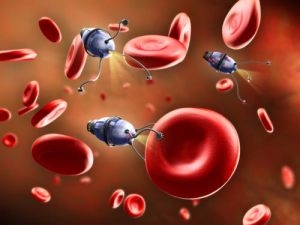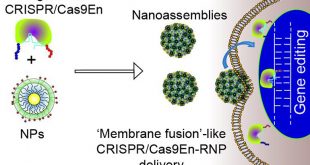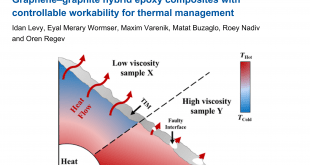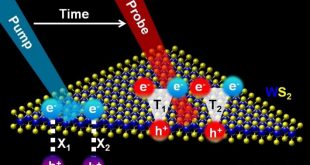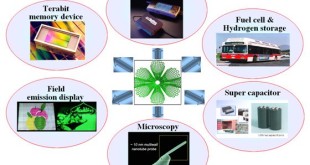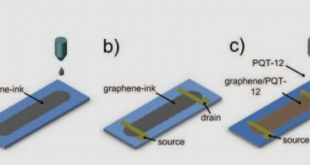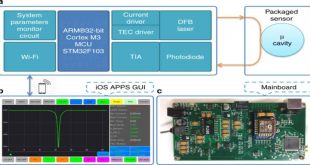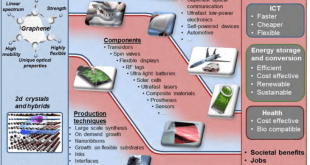Metamaterials are artificially structured materials designed to control and manipulate physical phenomena such as light and other electromagnetic waves, sound waves and seismic waves in unconventional ways, resulting in exotic behavior that’s not found in nature. This class of micro- and nano-structured artificial media are predicted to be able to protect …
Read More »Researchers use Graphene for miniature inductors enabling Ultra-Miniaturized Electronics Devices
The inductors along with capacitors and resistors, inductors are one of the three passive elements that are the foundations of all electronics. An inductor works by inducing a magnetic field as an electric current flows through its coil of wire. This magnetic field temporarily stores electric energy as magnetic energy, …
Read More »Nanomedicine entering mainstream to treat Cancer, HIV and Chem-Bio weapon threats.
Nanomedicine is a branch of medicine that applies the knowledge and tools of nanotechnology to the prevention and treatment of disease. Nanomedicines typically encapsulate therapeutic and/or imaging compounds in submicrometer-sized carrier materials. Nanomedicine involves the use of nanoscale materials, such as biocompatible nanoparticles and nanorobots, for diagnosis, delivery, sensing or …
Read More »Nanoparticles or Nanocapsules can deliver the CRISPR genome-editing system to most cells and tissues safely and efficiently
Within only a few years, research labs worldwide have adopted a new technology referred to as “CRISPR,”that facilitates making specific changes in the DNA of humans, other animals, and plants. Compared to previous techniques for modifying DNA, this new approach is much faster and easier. CRISPR allows removing a single (defective) …
Read More »Nanotechnology revolutionizing thermal management solutions in electronics
As computer processors have continued to shrink down to sizes where billions of transistors are on single chip, heat has increasingly become a bigger factor in their performance. If those CPUs did not get as hot in the first place, then much less energy would be needed to keep them …
Read More »“Trion” instead of electron will play a key role in Future electronics and Quantum information transmission
Trions are what scientists call “quasiparticles,” bundles of energy, electric charge and spin that zoom around inside semiconductors. Trions were first observed in quantum wells in 1993 and shortly thereafter in GaAs-AlGaAs quantum wells. Trions were were predicted and found in the photoluminescence and absorption spectra of various optically …
Read More »Carbon nanotubes revolutionising Military with miniature sensors, ultrawideband communications, micro robots and efficient power sources
Nanotechnology enables designing and creating structures and devices utilising extraordinary properties and behaviour of matter at very fine length scales – nanoscale level (10-9 m). Between 2001 and 2004, approximately 60 countries globally implemented national nanotechnology programmes. According to R.D Shelton, an international technology assessor, research and development in this …
Read More »Graphene-based ink for printed electronics and Wearable electronic textiles (e-textiles)
The emerging field of printed electronics requires a suite of functional materials for applications including flexible and large-area displays, radio frequency identification tags, portable energy harvesting and storage, biomedical and environmental sensor arrays, and logic circuits. To enable these technologies, functional materials must be integrated with suitable patterning technologies, …
Read More »Photonics & Nano technologies promise miniature sensors, and faster “Internet of photonic things,” for civil and military
Sensors allow humans to feel and understand their world, and their development lays the foundation for the fulfillment of information society and has formed a huge industry. For its implementation the Internet of Things relies heavily on sensor technology.In the grand world of the “internet of things” (IoT), there are …
Read More »Graphene’s biggest challenge has been high manufacturing cost for high quality , Industry now plans making it by the tonne
Graphene is a 1-atom-thick layer of tightly bonded carbon atoms arranged in a hexagonal lattice. Graphene the world’s first 2D nanomaterial, is widely regarded as the “wonder material” of the 21st century due to the combination of its extraordinary properties. As a single layer of graphite, it is the thinnest …
Read More » International Defense Security & Technology Your trusted Source for News, Research and Analysis
International Defense Security & Technology Your trusted Source for News, Research and Analysis


